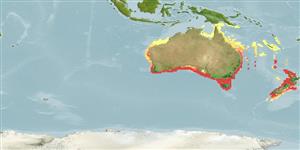Common names from other countries
分类 / Names
俗名 | 同种异名 | Catalog of Fishes(属, 种) | ITIS | CoL | WoRMS | Cloffa
Teleostei >
Carangiformes (Jacks)
鱸形目 (Jacks) >
Carangidae (Jacks and pompanos) > Caranginae
Etymology: Trachurus: Greek, trachys, -eia, -ys = rough + Greek, oura = tail (Ref. 45335).
More on author: Jenyns.
Environment: milieu / climate zone / depth range / distribution range
生态学
海洋; 半咸淡水 底中水层性; 深度上下限 27 - 460 m (Ref. 27930), usually ? - 300 m (Ref. 9072). 溫帶; ? - 16°C (Ref. 9072); 9°S - 53°S, 112°E - 177°E (Ref. 54926)
Southwest Pacific: Western Australia to New South Wales, including New Zealand. Principal component analysis of morphometric and meristic characters indicates three separate subpopulations in the Great Australian Bight, off New South Wales, and off Tasmania (Ref. 7456).
西南太平洋: 澳洲西部到新南威爾斯, 包括紐西蘭。 型態特徵與體節特徵的主要組成分析在大澳洲灣,外海的新南威爾斯與外海的塔斯梅尼亞中指出三個個別的子族群。 (參考文獻 7456)
Length at first maturity / 大小 / 重量 / 年龄
Maturity: Lm 31.5, range 23 - 37 cm
Max length : 64.0 cm SL 雄鱼/尚未辨别雌雄; (Ref. 33839); common length : 42.0 cm TL 雄鱼/尚未辨别雌雄; (Ref. 9258); 最大年龄: 25 年 (Ref. 9072)
背棘 (总数) : 9; 背的软条 (总数) : 29 - 35; 臀棘: 3; 臀鳍软条: 24 - 29; 脊椎骨: 24. Adults are elongate and slightly compressed, and have a primary lateral line with 71-89 scutes, and a secondary lateral line reaching to below dorsal-fin rays 7-9 (Ref. 33616).
成鱼是细长而些微扁长形, 而且有一个主侧线有 71-89个鳞甲 , 与一条第二的侧线延伸到背鳍鳍条 7-9 下面.(参考文献 33616)
Adults are commonly found near the bottom, in midwater and occasionally at the surface (Ref. 9258) in continental shelf waters (Ref. 27930). They form pelagic schools for most of the year but may move close to the sea bed during winter (Ref. 27931). Generally found at less than 300 m water depth with temperature less than 16° C (Ref. 9072). Juveniles inhabit coastal and estuarine waters although they may sometimes be found offshore (Ref. 27930). Adults feed mostly during the day mainly on krill and other planktonic crustaceans, light fish (Sternoptychidae) and lantern fish (Myctophidae) at the edge of the continental shelf (Ref. 27933).
普遍地在底部附近发现, 在中层水域中与偶然地在水表面 (参考文献 9258) 在大陆架水域中.(参考文献 27930) 他们形成大洋性的鱼群每年大部分的时间但是可能移动在冬天期间接近海床.(参考文献 27931) 用温度少于 16个 ° C 通常发现于少于 300个公尺水深了。 (参考文献 9072) 虽然他们有时可以被发现于外海,稚鱼栖息于海岸而河口的水域。 (参考文献 27930) 大部分在白天期间的吃在大陆架的边缘主要吃磷虾与其他的浮游性甲壳动物,日光灯鱼 (Sternoptychidae) 与灯笼鱼 (Myctophidae) 。 (参考文献 27933)
Eggs and sperm are released amongst schooling fish, possibly deep in the water column near the edge of the continental shelf. Eggs are distributed between the surface and the thermocline and larvae are carried inshore by currents.西南太平洋: 澳洲西部到新南威爾斯, 包括紐西蘭。 型態特徵與體節特徵的主要組成分析在大澳洲灣,外海的新南威爾斯與外海的塔斯梅尼亞中指出三個個別的子族群。 (參考文獻 7456)
Paxton, J.R., D.F. Hoese, G.R. Allen and J.E. Hanley, 1989. Pisces. Petromyzontidae to Carangidae. Zoological Catalogue of Australia, Vol. 7. Australian Government Publishing Service, Canberra, 665 p. (Ref. 7300)
CITES (Ref. 128078)
Not Evaluated
人类利用
渔业: 高经济性; 游钓鱼种: 是的; 诱饵: usually
工具
特别资料
下载 XML
网络资源
Estimates based on models
Preferred temperature (Ref.
115969): 11.1 - 20.2, mean 14.4 (based on 135 cells).
Phylogenetic diversity index (Ref.
82804): PD
50 = 0.5001 [Uniqueness, from 0.5 = low to 2.0 = high].
Bayesian length-weight: a=0.01259 (0.00780 - 0.02031), b=2.97 (2.83 - 3.11), in cm Total Length, based on LWR estimates for this species & Genus-body shape (Ref.
93245).
营养阶层 (Ref.
69278): 3.9 ±0.61 se; based on food items.
回复力 (Ref.
120179): 中等的, 族群倍增时间最少 1.4 - 4.4年 (tm=2-4; tmax=25).
Fishing Vulnerability (Ref.
59153): Moderate to high vulnerability (50 of 100).
Climate Vulnerability (Ref.
125649): Moderate vulnerability (36 of 100).
